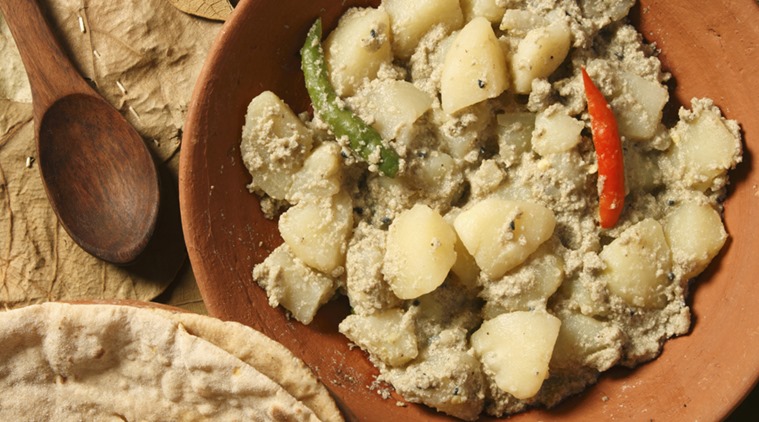The story of alu-posto and opium trade: An Article from the Indian Express by Pritha Sen


Can a residual by-product of the opium plant become a highly prized spice? It can. Ask any Bengali what he or she has had for lunch, and more often than not the answer will be Alu-Posto (potatoes in poppy seed paste). Or, maybe, it could be kancha posto (raw poppy-seed paste) with generous amounts of mustard oil and rice. It’s not for nothing that well-known author Chitrita Banerji says: “It’s used in other cuisines but its prolific, enthusiastic, even single minded utilisation is only to be seen in Bengal….”
Synonymous today with a perfect ‘Bengali’ meal, especially when teamed with biuli or urad dal, it is interesting to note that this coveted dish, which West Bengal proudly lays claim to (here I will request those who trace their roots to the erstwhile East Bengal to take a backseat) has rather unholy yet hugely historic antecedents.
Drug trade, exploitation and the Opium Wars
The opium poppy, from which posto, khus khus or poppy seeds is derived, has a long relationship with India, not as a gourmet ingredient but as a medicinal plant. A remedy for a number of ailments, it finds mention in the Dhanwantari Nighantu, one of the oldest Indian texts dealing with the properties of drugs. It slowly took on the form of a recreational drug during the reign of the Mughal emperor Akbar. Its cultivation was stepped up by royal diktat, and the beautiful crimson flower found a special place as well in royal textile motifs. The tiny dried white seeds formed after the drug had been extracted from the latex of the poppy seedpods were non-narcotic and crept into the royal kitchens primarily as a texture enhancer and thickener for gravies. The story may have ended there had not the British discovered the huge market for illegal opium in China soon after the Battle of Plassey in 1757, which is when they first set up their base in Bengal.
The crimson booty of the British
Overnight huge tracts of agricultural land in the Bengal Presidency were transformed into rolling poppy fields and while the native farmer lamented the death of golden harvests, the British raked in a crimson booty. English civil servants fanned out into the western areas of Bengal, into Bihar and Orissa, bleeding a once-thriving agricultural economy dry. Robbed of the produce that fed the family — a miserable state compounded by the ‘aphim’-induced stupor of her husband — the farmer’s wife looked for ways to supplement the meagre meals put together by foraging in forests, ponds and groves. The enormous amounts of dried out poppy seed, left as waste by the colonial masters, suddenly took on an important role. She experimented with it and found much to her delight that the seeds when ground to a paste exuded a nutty flavour, blended well with mustard oil and enhanced the frugal meals of panta bhaat (soaked leftover rice), or boiled potatoes. In the intense dry heat of the area, it also cooled the body. Thus was born the Bengali’s cherished posto. As Banerji observes: “An added bonus is its slightly soporific effect, which deepens the post lunch siesta for an ease loving Bengali”.
The rise and rise of posto
Not surprising then that it soon entered every Bengali home, crossing the Padma River into erstwhile eastern Bengal. It was used with tamarind as a refreshing cooler; in aumbole, the rich paste redolent with mustard oil; eaten raw or cooked with potatoes and various tubers such as yams and colocassia, and with fish and vegetables such as the ridge gourd or pointed gourd or brinjals, and it was a winner all the way.
The innovations continued primarily because posto had the entire region bordering the Chotanagpur Plateau, areas such as Bankura and Birbhum, in its thrall. It crept into the kitchens of Burdwan, travelled to Midnapore where it got added to the portfolio of kitchen art as ornamentation for Goyna bori (Jewellery Vadis), and occupied a place of honour in the Vaishnav vegetarian traditions of Nadia. It continues to dominate the palates and plates of those hailing from these regions.
Recipes featuring posto are aplenty today and range from simple fritters to main courses made with hitherto forbidden ingredients in Bengali vegetarian cuisine such as the peyanj posto, made with onions, or the roshun diye posto, made with garlic. As it entered the more sophisticated portals of urban kitchens it was added to eggs, fancier fish preparations and meats. The crowning glory was its use in the jewel of Bengal’s culinary legacy, the shukto. And, in an emulation of East European and European traditions of Jewish and British settlers in Calcutta — read poppy seed cakes and pastries and its use as a garnish on breads and savouries — the Bengali sandesh, too, was rolled in roasted poppy seeds to lend it a crunchy exterior.
Post-Independence, with the government clamping down hard on opium poppy cultivation, posto became an even more prized item due to its scarcity and, hence, exclusivity, and the once residual product climbed the price charts. Much like how the once humble pate or foie gras, made by European peasants from animal offal for protein and warmth in bitter winters now occupies pride of place on fine dining tables.
So next time you order an alu-posto at some Bengali restaurant, know that what you are eating is just a tip of an entire culinary repertoire born out of waste.
